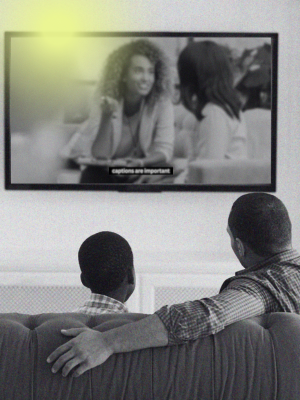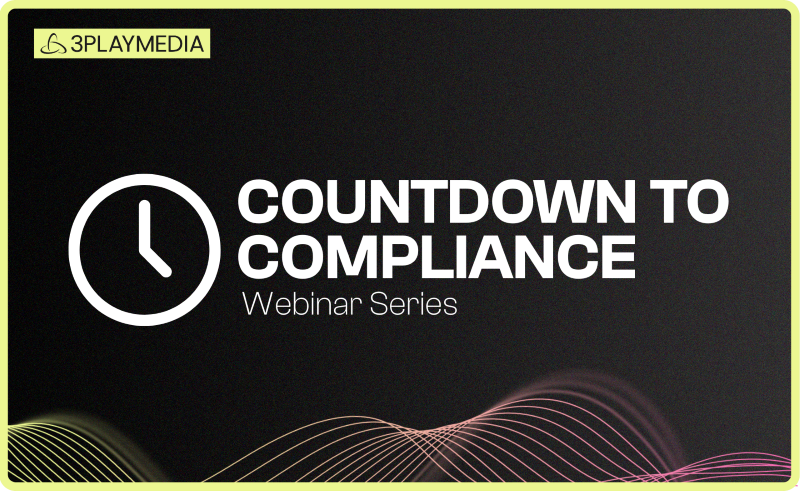- Legislation & Compliance
Everything to Know About the Americans with Disabilities Act (ADA) and Video Compliance
•

The Americans with Disabilities Act (ADA) is the most far-reaching piece of accessibility legislation in the United States. However, because the ADA was first introduced in 1990, it did not specifically address digital or web accessibility…until now.
Fast forward to April 2024, 34 years after its introduction into U.S. law, the Justice Department (DOJ) announced that they would publish “a final rule under Title II of the Americans with Disabilities Act (ADA) to ensure the accessibility of web content and mobile applications (apps) for people with disabilities.”
So what does ADA video compliance entail?
What is ADA Compliance for Videos?
ADA video compliance ensures that all video content provided by covered entities is accessible to individuals with disabilities, including synchronized captions, audio description, and accessible media players, as legally required by the Americans with Disabilities Act.
In this blog, we’ll give you a high-level overview of the ADA, explore how Titles II and III of the ADA apply to web accessibility, learn what the DOJ’s new rule means, and share tips for making your videos accessible and ADA-compliant.
Key Takeaways
- ADA video compliance ensures equal access through captions, audio descriptions, and accessible players.
- The DOJ’s 2024 rule requires public institutions to meet WCAG 2.1 Level AA for all web and video content.
- Public universities must prepare now to meet 2026–2027 deadlines and maintain ongoing accessibility.
Overview of the Americans with Disabilities Act (ADA)
Enacted in 1990, this civil rights statute was created to limit discriminatory practices towards individuals with disabilities. This act and its amendments guarantee equal opportunity for persons with disabilities in employment, state and local government services, public accommodations, commercial facilities, and transportation.
Both public and private entities are affected by the ADA–it is the responsibility of these entities to provide equal access through accommodations to suit a disabled individual’s needs.
Disabilities covered under the ADA can be physical (e.g., muscular dystrophy, dwarfism, etc.), sensory (e.g., blindness, D/deafness, deaf-blindness), or cognitive (e.g., Down Syndrome).
In 2008, the Americans with Disabilities Amendment Act broadened the scope of how disability is legally defined: psychological, emotional, and physiological conditions are now included.
The Americans with Disabilities Act consists of five sections overseeing different aspects of life and an individual’s engagement with society:

- Title I: Employment
- Title II: Public Entities
- Title III: Public Accommodations
- Title IV: Telecommunications
- Title V: Miscellaneous Provisions
ADA Compliance for Videos
The ADA considers captioning and audio description to be “auxiliary aids” in communication. “Auxiliary aids” are assistive technology, services, or devices for people with disabilities, allowing equal access to goods or services provided to the public.
Captions and audio description are examples of assistive technology that help make online and broadcasted videos accessible.
The recent new rule under Title II of the ADA lists web video captioning as a requirement for state and local government entities (including public schools and universities). Private entities are not yet affected, but the rule sets new precedence for web video accessibility and supports previous ADA lawsuit outcomes.
Both Title II and Title III of the ADA have been interpreted to apply to web accessibility and video captioning in various ADA-based lawsuits over the past couple of decades. Let’s take a closer look at these Titles to discover how they’re used.
ADA Title II: State and Local Public Entities Must Be Accessible
Title II prohibits disability discrimination by all public entities at the federal, state, and local level. For example, public colleges and universities, schools, courts, police departments, and public libraries must comply with Title II. Compliance is required regardless of whether they receive federal funding.
Title II mandates that state and local governments:
- May not refuse to allow a person with a disability to participate in a service, program, or activity simply because the person has a disability.
- Must provide programs and services in an integrated setting, unless separate or different measures are necessary to ensure equal opportunity.
- Must furnish auxiliary aids and services when necessary to ensure effective communication, unless an undue burden or fundamental alteration would result.
- Must operate programs so that, when viewed in their entirety, they are readily accessible to and usable by individuals with disabilities.

Websites for public entities should also be fully accessible to users who are D/deaf, blind or have limited dexterity.
Under Title II, publicly available videos, whether for entertainment or informational use, must be made accessible to individuals with disabilities. That means including captions on videos both in person and online so that people who are D/deaf or hard of hearing can access public services.
Title II also applies to employment in public entities, meaning disabled employees must not be barred from performing responsibilities because of inaccessible processes or procedures. State and local entities need to caption videos for internal communication and training, as well as public-facing material.
ADA Compliance in Higher Education: Final Ruling
The U.S. Department of Justice’s (DOJ) final rule on Title II of the Americans with Disabilities Act (ADA) provides much-needed clarity for public universities, community colleges, and other state or local government entities regarding web content and mobile app accessibility.
The rule, finalized in April 2024 and effective June 24, 2024, establishes WCAG 2.1 Level AA as the official standard for accessible digital content, with compliance deadlines set for 2026 or 2027 depending on the population of the local government.
This rule requires higher education institutions to ensure that their websites, mobile apps, and all digital educational content meet specific accessibility standards. Key video requirements under WCAG 2.1 include:
- Pre-recorded video captions (1.2.2): All pre-recorded videos must include accurate, synchronized captions for deaf and hard-of-hearing viewers.
- Audio-only transcripts (1.2.3): Text alternatives must be provided for all audio-only content.
- Live captions (1.2.4): Live audio content in synchronized media must include captions.
- Audio descriptions (1.2.5): Pre-recorded videos must include audio description tracks that convey important visual information for blind or low-vision users.
Learn more about WCAG requirements by downloading our free eBook: A Practical Guide
to WCAG Video Accessibility Requirements.
Title II Compliance Deadlines
Compliance deadlines vary by population size:
- April 24, 2026 for public entities in areas with populations of 50,000 or more
- April 26, 2027 for smaller entities with populations under 50,000
Institutions should reference the local population (not student body size) using 2020 U.S. Census data.
Limited exceptions exist for archived web content and preexisting social media posts, but password-protected content is not exempt and must also meet WCAG 2.1 AA standards within the compliance window.

To prepare, institutions should:
- Familiarize themselves with WCAG 2.1 Level AA standards.
- Audit existing web and mobile content for captions, audio descriptions, and accessibility of interactive elements.
- Ensure that vendor-provided content also complies, as ADA obligations extend to content obtained through licensing, contracts, or other third-party arrangements.
Working with an experienced accessibility vendor like 3Play Media can simplify the process, helping your institution meet compliance efficiently while creating an inclusive digital learning environment for all students.
ADA Title III: Places of Public Accommodation
Commercial entities – such as hotels, libraries, museums, train stations, airports, restaurants, movie theaters, retail stores, and hospitals – are covered by Title III of the ADA.
Under Title III, no individual may be discriminated against on the basis of disability with regards to the full and equal enjoyment of the goods and services at any place of public accommodation.
What is a Place of Public Accommodation?
The three criteria of a “place of public accommodation” are:
- It must be operated by a private entity
- Its operations must affect commerce
- It must fall within one of the following 12 categories
12 Categories of Public Accommodation
- Places of lodging.
- Establishments serving food or drink.
- Places of exhibition or entertainment.
- Places of public gathering.
- Sales or rental establishments.
- Service establishments.
- Stations used for specified public transportation.
- Places of public display or collection.
- Places of recreation.
- Places of education.
- Social service center establishments.
- Places of exercise or recreation.
For a more detailed list of the organizations that fall under ‘place of public accommodations,’ check the ADA’s definition section.
Does the ADA Title III Apply to Online Businesses?

Before the internet became so ubiquitous, it was assumed that the ADA applied only to physical structures. But because the law didn’t specifically state whether it applied to brick-and-mortar vs. digital “places,” it became open to interpretation.
A string of high-profile lawsuits against private companies for inaccessible websites, web services, or digital communications, has created a precedent that the ADA applies to the internet.
This precedent has only strengthened over time, with UsableNet reporting an increase in web accessibility lawsuits against private organizations annually, and the DOJ’s recent rule mandating digital accessibility rules for Title II, which covers state and government entities.
Let’s take a look at a few important disability discrimination lawsuits to get a sense of how the ADA has historically been interpreted to apply to the web.
ADA Lawsuits on Web Accessibility
NFB v. Target and EEOC & NAD v. FedEx
The National Federation of the Blind (NFB) sued Target Corporation over its public retail website in 2006. The NFB claimed that blind people were unable to access much of the information on Target’s site and could not purchase anything independently.
The NFB and Target Corporation reached a settlement in 2008 and was one of the first major cases that helped define the relationship between the internet and the ADA.
FedEx was sued by the Equal Employment Opportunity Commission (EEOC) and the National Association of the Deaf (NAD) in 2014. The suit alleged failure to provide ASL interpreters, closed captioning for training videos, and modifications to equipment. In 2020, FedEx settled with the EEOC under a Consent Decree.
NAD v. Netflix
In 2010, Netflix was sued by the NAD for discriminating against D/deaf and hard-of-hearing viewers due to insufficient closed captions.
This marked the first interpretation of the ADA applying to online-only businesses. In 2012, Netflix settled by agreeing to caption all content retroactively and going forward. The settlement leaves room for debate on ADA application to online-only businesses.
Similar lawsuits were brought against streaming giants Hulu and Amazon a few years later.
NAD v. Harvard and MIT
In 2015, the NAD sued Harvard and MIT over concerns that the universities were not providing equal access to online programming for students with disabilities. The NAD cited violations of the ADA and the Rehabilitation Act.
Notably, these lawsuits were the first of their kind to address the accuracy and quality of the captions provided.
In 2019, the NAD and Harvard came to an agreement through a Consent Decree that establishes captioning guidelines, citing 3Play Media’s high accuracy as an example. The NAD and MIT settled in 2020 under a similar agreement.
Department of Justice (DOJ) & NAD vs. UC Berkeley
The NAD filed a complaint in 2014 against UC Berkeley, citing the lack of closed captions in its online courses and content.
The DOJ validated the complaint and required UC Berkeley to rectify ADA violations, leading to an investigation that broadened to encompass overall media and web accessibility for all learners.
In 2022, UC Berkeley and the Department of Justice (DOJ) reached an agreement regarding the accessibility of the university’s online content, ensuring its free online content is accessible to learners with a range of disabilities.
How to Implement ADA-Compliant Video Accessibility
Understanding the legal requirements is one thing. Putting them into practice is another. To create truly accessible video content that meets ADA and WCAG 2.1 AA standards, organizations should focus on three key implementation areas: captions, audio descriptions, and player accessibility.
1. Add Accurate Captions
Captions make videos accessible for D/deaf and hard-of-hearing viewers, and they benefit everyone who watches without sound.
- Pre-recorded content: Include closed captions that accurately reflect all spoken dialogue and relevant sounds (like [applause], [music], or [doorbell rings]).
- Live content: Provide live captions for live streams, webinars, and broadcasts.
- Quality matters: Captions must be accurate, complete, synchronized with speech, and properly positioned on-screen. Automatic captions can be a helpful starting point, but they should always be reviewed and corrected for accuracy.

Learn more about 3Play Media’s 99% accurate captioning solutions.
2. Include Audio Descriptions
Audio descriptions provide a spoken narration of important visual information, like actions, on-screen text, or scene changes, for people who are blind or have low vision.
- Plan during production: Write your script with accessibility in mind, leaving pauses for audio description where possible.
- Create a description track: Record a secondary audio track that describes the visual elements of your video.
- Add it to your media player: Many platforms and players support multiple audio tracks so users can enable descriptions as needed.
Learn about our AI-enabled, human-perfected audio description solutions.
3. Ensure Video Player Accessibility
An accessible video player is just as important as the video itself. Users with motor disabilities, blindness, or low vision must be able to navigate and control playback with assistive technologies.
Check that your player:
- Can be operated with a keyboard (using Tab, Enter, Space, or arrow keys).
- Displays visible focus indicators for all controls.
- Works properly with screen readers and supports captions and audio description toggles.
- Has sufficient contrast for control icons and text.
4. Test and Verify Accessibility
Testing ensures your accessibility efforts actually work as intended.
- Manual testing: Play the video using only a keyboard to confirm all controls are accessible.
- Assistive tech testing: Use screen readers (like NVDA or VoiceOver) to verify that captions and descriptions are announced properly.
- Automated tools: Run your video page through accessibility checker tools to catch missing attributes or color contrast issues.
5. Maintain Accessibility Over Time
Accessibility isn’t a one-time task; it’s an ongoing process. Review new video uploads regularly, update old content, and include accessibility checks in your publishing workflow.
3Play Media’s ADA Compliance Services
Ensuring your videos meet ADA Title II requirements can feel complex, but 3Play Media makes accessibility simple and scalable.
Our full-service solutions combine advanced AI technology with expert human review to provide highly accurate closed captions, audio descriptions, and more for all your web and mobile video content.
- Caption all pre-recorded and live video content to meet legal requirements for deaf and hard-of-hearing viewers.

- Add audio descriptions that convey important visual information for blind or low-vision audiences.
- Ensure accessible media players that work with keyboard navigation, screen readers, and other assistive technologies.
- Dedicated Customer Support—Our accessibility experts provide personalized guidance and ongoing support to help you navigate ADA Title II compliance every step of the way.
Whether you’re a public university, community college, or state agency, 3Play Media helps you meet ADA Title II deadlines efficiently while creating an inclusive digital experience for all learners.
Schedule a consultation with our team to discover how we can fast-track your path to Title II compliance:

ADA Video Compliance FAQs
ADA captioning requirements mandate that all video content include accurate, synchronized captions so people who are deaf or hard of hearing can fully access the information.
While the ADA itself doesn’t list technical specifications, the technical standard mandated by the new ADA Title II rule (WCAG 2.1 Level AA) effectively requires captions for all pre-recorded and live video content that contains synchronized audio.
The ADA Title II video compliance deadlines vary by population size: public entities in areas with 50,000 or more people must comply by April 24, 2026, while smaller entities must comply by April 26, 2027.
Yes, live videos must include real-time captions under the ADA to ensure that deaf and hard-of-hearing viewers can access the content as it happens.
Filed under
About the author
Share this page
Related Posts
-
 Read more: A University Guide to Budgeting and Auditing for ADA Video Compliance
Read more: A University Guide to Budgeting and Auditing for ADA Video Compliance- Legislation & Compliance
A University Guide to Budgeting and Auditing for ADA Video Compliance
-
 Read more: Subtitling vs. Dubbing: Which is Right for Your Audience?
Read more: Subtitling vs. Dubbing: Which is Right for Your Audience?- Subtitling
Subtitling vs. Dubbing: Which is Right for Your Audience?
-
 Read more: What Is Dubbing? Everything You Need to Know About Dubbing Videos
Read more: What Is Dubbing? Everything You Need to Know About Dubbing Videos- Dubbing
What Is Dubbing? Everything You Need to Know About Dubbing Videos





